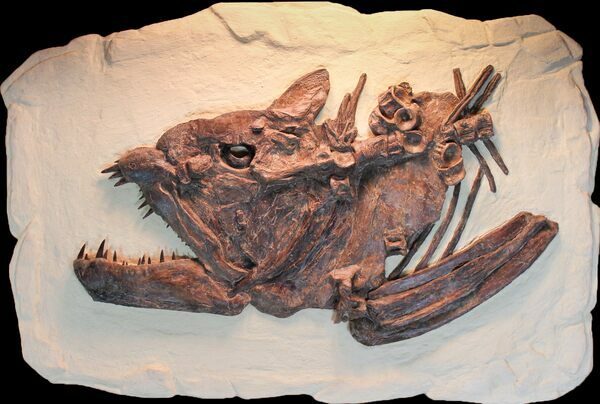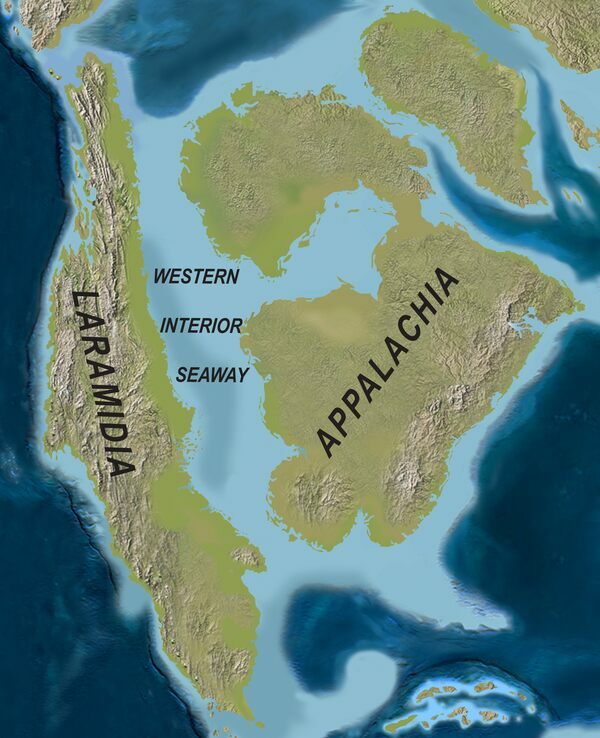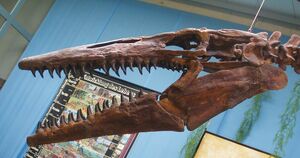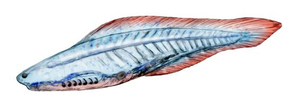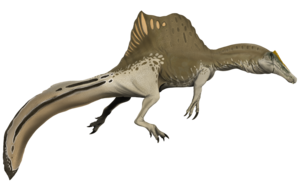Xiphactinus, Terror Of The Inland Seaway
Xiphactinus was one of the largest bony fish ever to have lived and was truly a monster. It ranged in size from 15-20 feet (4.5 - 6m) and would have looked like a toothy, oversized tarpon. It lived during the Cretaceous period from about 112 million years ago up to the Cretaceous-Palaeogene Extinction, 65 million years ago.
Xiphactinous is often described as a voracious predator. Gluttonous is also an apt descriptor. It would have fed on whatever it could get its teeth on. This would include smaller fish, turtles, pterosaurs, and even juvenile mosasaurs. It probably even scavenged if the opportunity presented. A number of skeletons of Xiphactinus have been found with undigested prey in their stomachs. The most famous of these is at the Sternberg Museum of Natural History in Hays Kansas. A thirteen foot long Xiphactinus has a completely preserved, six foot long Gillicus arctuatis in its stomach. It is likely that Xiphactinous died shortly after ingesting such large prey. Talk about indigestion!
It has a very long, slender body like a torpedo which would likely allowed it to reach extremely fast speeds when chasing prey. Some estimates are that it had a top speed close to 60km/hour (37 miles/hour). Given it's shape many also suspect that it could leap out of the water like modern dolphins and may have also preyed upon pterosaurs at the surface.
Xiphactinus lived is shallow seas like the Western Interior Seaway of North America. This was a body of water that divided what we now think of as North America into three distinct land masses. Aside from the unfamiliar species, it would have looked for the most part like any saltwater shoreline we would see today. The marine environment included all levels of life from plankton to apex predators. There were mollusks including ammonites and belemnites. Fish from the diminutive Chirocentrites to larger Enchodus, Pachyrhizodus and Ichthyodectes. Large, marine reptiles like Mosasaurs, Elasmosaurs and Ichthyosaurs would have occupied the top of the food chain. Just below them would come the sharks, Squalicorax, Cretoxyrhina. In addition to the marine animals, early birds and Pterosaurs like Nyctosaurus and Pteranodon would have occupied the air currents above the water.
While fossils of Xiphactinus can be found in many locations around the world from Europe to Australia, the Niobrara chalk beds of Kansas maybe the most famous and prolific locality. In fact, it was first discovered in Kansas and named by Professor Leidy in 1870. Its name means “sword ray.” Dozens of complete Xiphactinus, some over 20 feet long has been recovered along with numerous partial skeletons and thousands of fossil vertebrae.
Xiphactinous is often described as a voracious predator. Gluttonous is also an apt descriptor. It would have fed on whatever it could get its teeth on. This would include smaller fish, turtles, pterosaurs, and even juvenile mosasaurs. It probably even scavenged if the opportunity presented. A number of skeletons of Xiphactinus have been found with undigested prey in their stomachs. The most famous of these is at the Sternberg Museum of Natural History in Hays Kansas. A thirteen foot long Xiphactinus has a completely preserved, six foot long Gillicus arctuatis in its stomach. It is likely that Xiphactinous died shortly after ingesting such large prey. Talk about indigestion!
It has a very long, slender body like a torpedo which would likely allowed it to reach extremely fast speeds when chasing prey. Some estimates are that it had a top speed close to 60km/hour (37 miles/hour). Given it's shape many also suspect that it could leap out of the water like modern dolphins and may have also preyed upon pterosaurs at the surface.
Where did Xiphactinus live?
Xiphactinus lived is shallow seas like the Western Interior Seaway of North America. This was a body of water that divided what we now think of as North America into three distinct land masses. Aside from the unfamiliar species, it would have looked for the most part like any saltwater shoreline we would see today. The marine environment included all levels of life from plankton to apex predators. There were mollusks including ammonites and belemnites. Fish from the diminutive Chirocentrites to larger Enchodus, Pachyrhizodus and Ichthyodectes. Large, marine reptiles like Mosasaurs, Elasmosaurs and Ichthyosaurs would have occupied the top of the food chain. Just below them would come the sharks, Squalicorax, Cretoxyrhina. In addition to the marine animals, early birds and Pterosaurs like Nyctosaurus and Pteranodon would have occupied the air currents above the water.
While fossils of Xiphactinus can be found in many locations around the world from Europe to Australia, the Niobrara chalk beds of Kansas maybe the most famous and prolific locality. In fact, it was first discovered in Kansas and named by Professor Leidy in 1870. Its name means “sword ray.” Dozens of complete Xiphactinus, some over 20 feet long has been recovered along with numerous partial skeletons and thousands of fossil vertebrae.
 Reviews
Reviews
